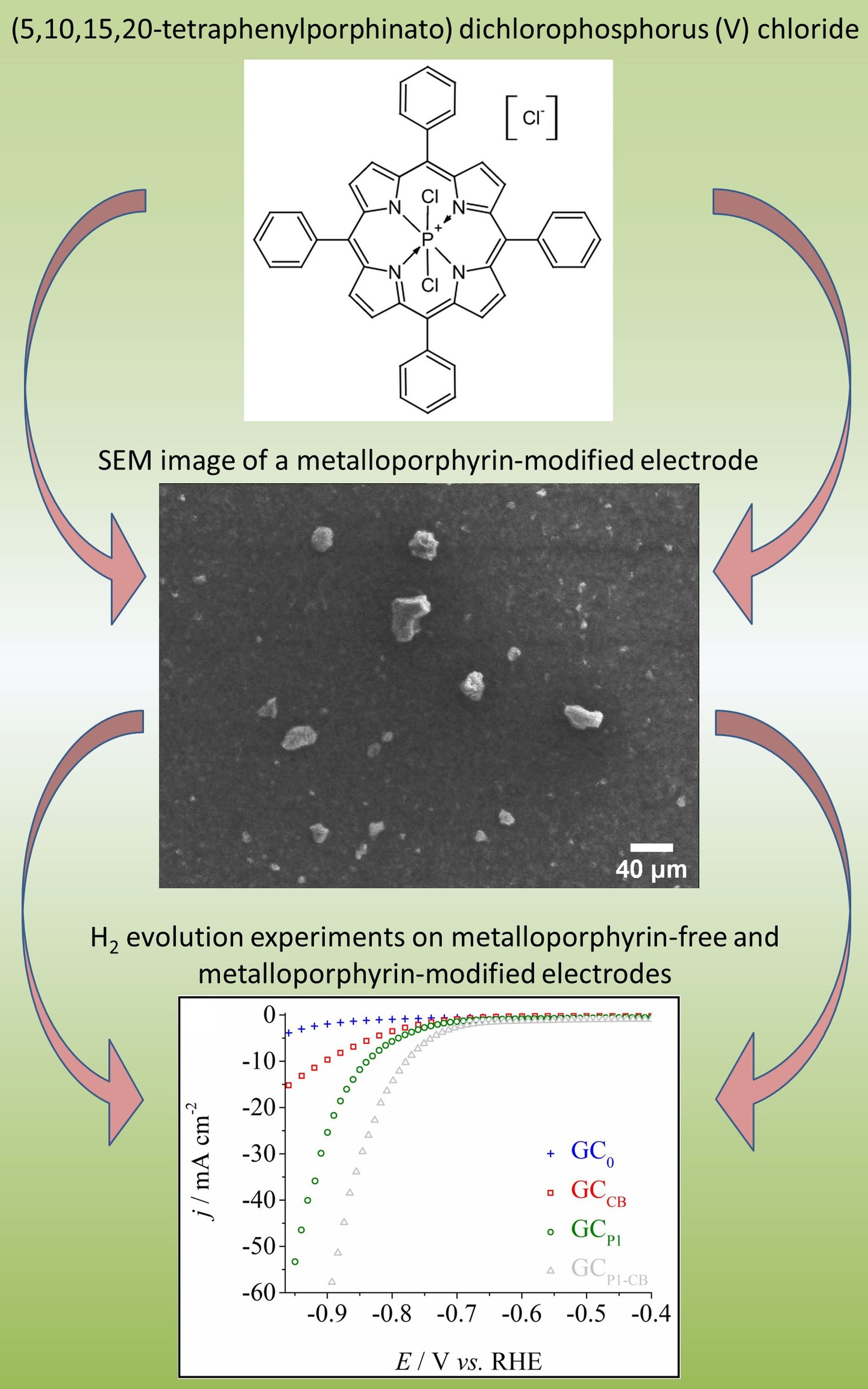Different electrode modification protocols for evaluating the water-splitting properties of a P(V)-metalloporphyrin Scientific paper
Main Article Content
Abstract
Water electrolysis is currently a notable research domain, having the identification of highly active, stable, and low-cost electrocatalysts as one of its most important pursuits. Herein, an A4 P(V)-centered metalloporphyrin – (5,10,15,20-tetraphenylporphinato) dichlorophosphorus(V) chloride – was evaluated in terms of its electrocatalytic water-splitting activity in acidic, neutral, and alkaline media. The experiments were performed on electrodes modified with the porphyrin complex using different protocols, and the most electrocatalytically active sample was the one obtained by applying a catalyst ink containing the metalloporphyrin and Carbon Black on glassy carbon. The best results were observed for the strongly alkaline medium (1 mol L-1 KOH), in which the electrode exhibited a hydrogen evolution reaction overpotential of 0.77 V and a Tafel slope of 0.135 V dec-1. Its stability was outlined by chronoamperometry and Raman spectroscopy. The results supplement the available data regarding the properties and applicative potential of metalloporphyrins and outline the implications of using different electrode manufacturing procedures.
Downloads
Metrics
Article Details

This work is licensed under a Creative Commons Attribution 4.0 International License.

Authors retain copyright and grant the journal right of first publication with the work simultaneously licensed under a Creative Commons Attribution license 4.0 that allows others to share the work with an acknowledgement of the work's authorship and initial publication in this journal.
References
B.-O. Taranu, E. Fagadar-Cosma, Processes 10 (2022) 1 (https://doi.org/10.3390/pr10030611)
B.-O. Taranu, E. Fagadar-Cosma, Nanomaterials-Basel 12 (2022) 1 (https://doi.org/10.3390/nano12213788)
B.-O. Taranu, S. F. Rus, E. Fagadar-Cosma, Coatings 14 (2024) 1 (https://doi.org/10.3390/coatings14081048)
B. O. Taranu, S. D. Novaconi, M. Ivanovici, J. N. Goncalves, F. S. Rus, Appl. Sci.-Basel 12 (2022) 1 (https://doi.org/10.3390/app12136821)
S. Seo, K. Lee, M. Min, Y. Cho, M. Kim, H. Lee, Nanoscale 9 (2017) 3969 (https://doi.org/10.1039/C6NR09428G)
G. Cai, L. Zeng, L. He, S. Sun, Y. Tong, J. Zhang, Chem.-Asian J. 15 (2020) 1963 (https://doi.org/10.1002/asia.202000083)
A. Wang, L. Cheng, W. Zhao, X. Shen, W. Zhu, J. Colloid Interf. Sci. 579 (2020) 598 (10.1016/j.jcis.2020.06.109)
Y. Wu, J. M. Veleta, D. Tang, A. D. Price, C. E. Botez, D. Villagran, Dalton T. 47 (2018) 8801 (https://doi.org/10.1039/C8DT00302E)
J. Ma, L. Liu, Q. Chen, M. Yang, D. Wang, Z. Tong, Z. Chen, Appl. Surf. Sci. 399 (2017) 535 (https://doi.org/10.1016/j.apsusc.2016.12.070)
H. Sahabudeen, H. Qi, B. A. Glatz, D. Tranca, R. Dong, Y. Hou, T. Zhang, C. Kuttner, T. Lehnert, G. Seifert, U. Kaiser, A. Fery, Z. Zheng, X. Feng, Nat. Commun. 7 (2016) 1 (https://doi.org/10.1038/ncomms13461)
H. Jia, Y. Yao, Y. Gao, D. Lu, P. Du, Chem. Commun. 52 (2016) 13483 (https://doi.org/10.1039/C6CC06972J)
Y. Ge, Z. Lyu, M. Marcos-Hernandez, D. Villagran, Chem. Sci. 13 (2022) 8597 (https://doi.org/10.1039/D2SC01250B)
N. Ocuane, Y. Ge, C. Sandoval-Pauker, D. Villagran, Dalton T. 53 (2024) 2306 (https://doi.org/10.1039/D3DT03371F)
I. Fratilescu, A. Lascu, B. O. Taranu, C. Epuran, M. Birdeanu, A.-M. Macsim, E. Tanasa, E. Vasile, E. Fagadar-Cosma, Nanomaterials-Basel 12 (2022) 1 (https://doi.org/10.3390/nano12111930)
B.-O. Taranu, E. Fagadar-Cosma, P. Sfirloaga, M. Poienar, Energies 16 (2023) 1 (https://doi.org/10.3390/en16031212)
D. Huang, J. Lu, S. Li, Y. Luo, C. Zhao, B. Hu, M. Wang, Y. Shen, Langmuir 30 (2014) 6990 (https://doi.org/10.1021/la501052m).





